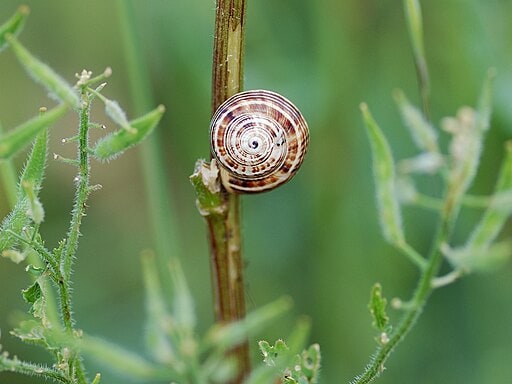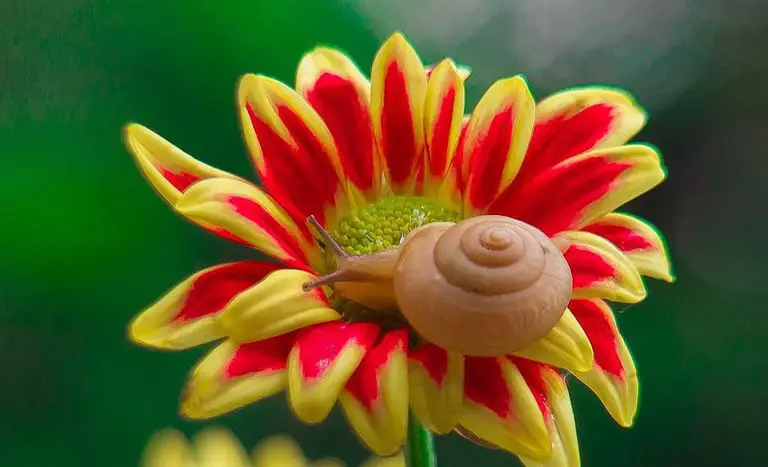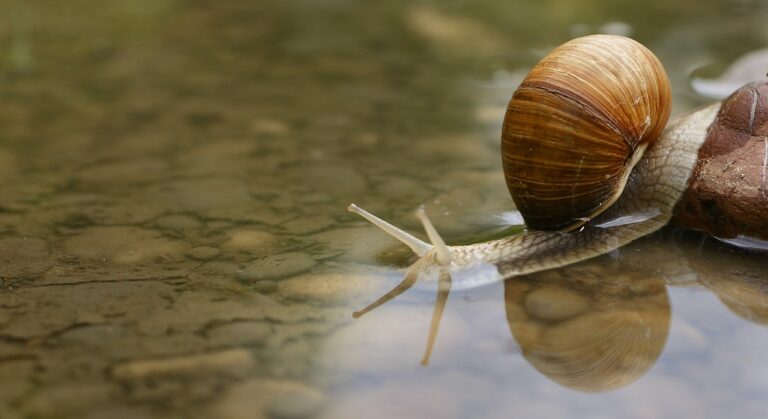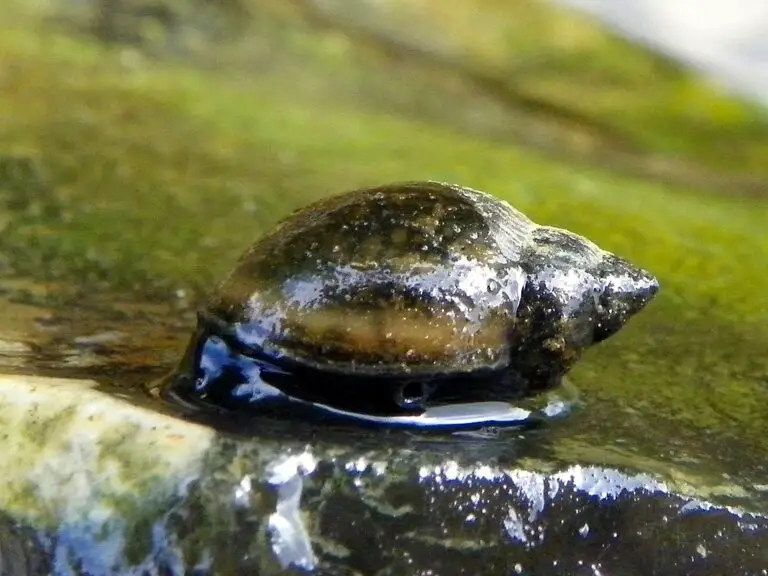Where Do Snails Live?
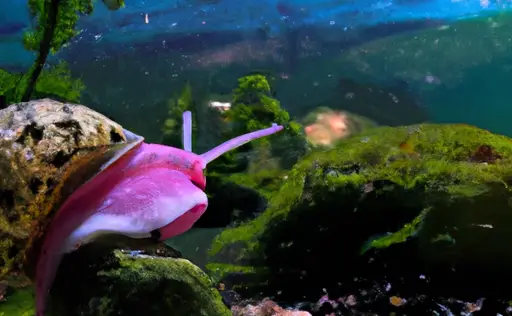
From Land to Desert and Everywhere in Between
Snails are fascinating creatures that can be found all over the world. While they may seem slow and unremarkable, they are actually quite diverse in their appearance and habitats. Snails belong to the class Gastropoda, which means “stomach foot” in Greek.
They have a single spiral shell and a muscular foot that allows them to move around. One of the most interesting things about snails is how adaptable they are to different types of environments.
From deserts to rainforests, there is a snail species that has evolved to thrive in almost every type of habitat on Earth. In this article, we’ll explore some of the different habitats where you might find snails.
The Habitats of Land Snails
Land snails are probably the most common type of snail you’ll encounter. They can be found in gardens, fields, forests – pretty much anywhere there is vegetation for them to eat and moisture for them to survive. Land snails prefer moist environments with plenty of shade since they can quickly dry out in hot sun.
There are many different species of land snail with varying shell shapes and colors. Some examples include garden snails (Helix aspersa), which have brown shells with stripes or spots, and Roman snails (Helix pomatia), which have large yellow shells with dark brown markings.
In terms of their habitat requirements, land snails tend to prefer areas with lots of vegetation such as shrubs or grasses, as well as areas where there is plenty of organic matter on the ground such as leaf litter or mulch. They also require moist soil or other surfaces so that their bodies don’t dry out.
The Habitats of Aquatic Snails
Aquatic snails can be found in freshwater environments like ponds, streams, and rivers. They are adapted to live in water and have special breathing organs that allow them to extract oxygen from the water.
Some species of aquatic snail also have gills for breathing. Just like land snails, there are many different types of aquatic snail with varying appearances and habits.
Some examples include apple snails (Pomacea canaliculata), which have large, brightly colored shells, and ramshorn snails (Planorbidae spp.), which have flat, disc-shaped shells. Aquatic snails prefer still or slow-moving water environments where they can find food sources such as algae or other plants.
They also require clean water since they are sensitive to pollutants or changes in water chemistry. In order to avoid predators like fish or turtles, some species of aquatic snail will hide under rocks or in vegetation.

The Habitats of Tree-dwelling Snails
Tree-dwelling snails are a bit more specialized than land or aquatic snails since they require specific environments in order to survive. They can be found living on trees in tropical rainforests as well as temperate forests around the world.
Some examples of tree-dwelling snail species include the giant African land snail (Achatina fulica) and the golden apple snail (Pomacea bridgesii). These types of snails have adapted to life on trees by developing sticky mucus that allows them to climb bark surfaces.
Tree-dwelling snails require moist tree bark surfaces as well as plenty of vegetation nearby for food sources. They often feed on mosses growing on tree bark or lichen that grows on branches.
The Habitats of Desert-dwelling Snails
Desert-dwelling snails might seem like an unlikely occurrence given the harsh conditions found in deserts around the world but these creatures do exist! They have adapted to the hot, dry environments of places like the Sahara or Sonoran deserts in order to survive. One example of a desert-dwelling snail is the desert banded snail (Xerocrassa mesostena).
This type of snail has evolved with a flattened shell that allows it to burrow into sand and avoid predators. To survive in harsh conditions, desert-dwelling snails are also able to aestivate, which means they can enter a state of dormancy during extremely dry or hot periods.
Desert-dwelling snails require sandy soil surfaces as well as moisture from occasional rainfall or dew. They also tend to be more active at night when temperatures are cooler.
Conclusion: The Diverse World of Snail Habitats
As we’ve seen, there are many different types of snails with varying appearances and habitats around the world. From land and aquatic species to tree-dwellers and even desert-adapted types, these creatures have managed to thrive in almost every environment on Earth. Whether you’re looking for them crawling across your garden or burrowing into sand dunes, keep an eye out for these fascinating creatures next time you’re out exploring!
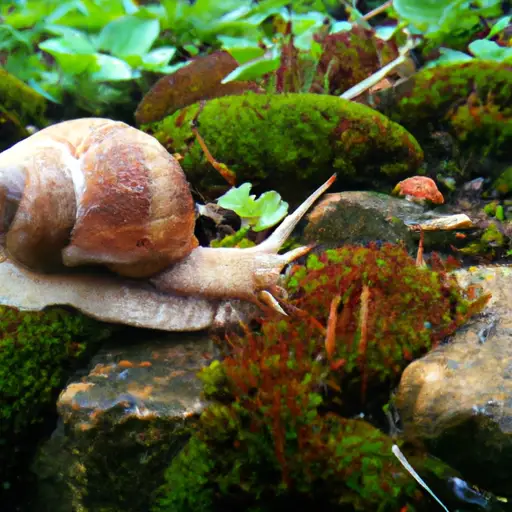
Land Snails: Slimy Creatures on Solid Ground
Land snails are a common sight in many parts of the world. These slimy gastropods can be found in a wide variety of environments, from forests to deserts and everything in between.
They are known for their slow pace and unique appearance, with a soft body protected by a hard shell. One of the most important things to know about land snails is that they prefer moist, shady areas.
This is because they need a certain level of humidity to survive, as their bodies are relatively delicate and can dry out quickly if exposed to too much sun or wind. Many land snail species can be found in forests, where the tree canopy provides ample shade and moisture from dew and rainfall.
However, not all land snails live exclusively in forested areas. Some species can be found in more open habitats such as fields or meadows, where there is still enough vegetation to provide shade and moisture.
Others may live in rocky or mountainous areas, where they can find shelter from the elements under rocks or crevices. There are countless different species of land snails throughout the world, each with its own unique characteristics and preferred habitat.
For example, Helix pomatia (also known as the Roman snail) is often found in gardens and hedgerows across Europe. Achatina fulica (the giant African land snail) prefers tropical climates and can be found across Africa as well as parts of Asia and South America.
While they may not be everyone’s favorite creature due to their slimy appearance, land snails play an important role in many ecosystems around the world. By understanding where they live and what environments they prefer, we can better appreciate these fascinating creatures that have been around for millions of years!
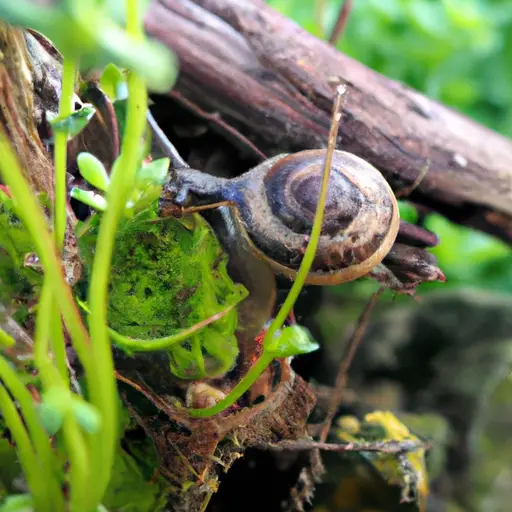
Aquatic Snails: Living Life in the Water
Aquatic snails are fascinating creatures that live their entire lives in water. They can be found in a variety of environments, including ponds, streams, and rivers. These snails have unique adaptations that allow them to survive and thrive in their aquatic habitats.
When it comes to water environments, aquatic snails prefer still or slow-moving water. This is because fast-moving water can be too turbulent for them to attach themselves to surfaces or move around easily.
Still or slow-moving water allows them to feed on algae and other microorganisms that grow on rocks and plants. One example of an aquatic snail species is the pond snail.
Pond snails are commonly found in freshwater ponds and are able to tolerate a wide range of temperatures. They feed on algae and other small organisms that grow on rocks and plants at the bottom of ponds.
Another example is the ramshorn snail, which has a unique spiral shell that resembles a ram’s horn. These snails are known for their ability to reproduce quickly and can often be seen moving along the bottom of streams looking for food.
Other examples include apple snails, which have large shells and can grow up to six inches in diameter, and mystery snails which are native to Asia but have been introduced around the world as aquarium pets due to their interesting appearance. Aquatic snails are amazing creatures adapted perfectly for life underwater.
They prefer still or slow-moving water where they can thrive on algae and other microorganisms growing on surfaces such as plant stems, rocks, or logs at the bottom of ponds or streams. With various species such as pond snails, ramshorn snails, apple snails, among others – each with unique characteristics – one cannot help but appreciate how diverse these creatures really are!
Tree-dwelling snails: Exploring the World of Arboreal Gastropods
When we think of snails, we usually imagine them slowly crawling on the ground or in ponds. However, there is a fascinating subset of snails that live high up in the trees – tree-dwelling snails. These gastropods can be found in a variety of forested areas around the world, including tropical rainforests, temperate forests, and even some urban parks.
Tree-dwelling snails have evolved to live on trees by developing certain adaptations that allow them to stick to bark and move around more easily. They are usually smaller than land snails and have more elongated shells that help them climb up and down branches.
They also tend to have flatter shells which allow them to move smoothly along surfaces without getting stuck. One type of tree-dwelling snail is the giant land snail (Achatina fulica), which can be found in tropical areas such as Southeast Asia and parts of Africa.
While they are primarily land dwellers, these giant gastropods will climb trees in search of food or shelter during heavy rains or hot weather. Another species is the gray-footed salamander (Macroclemys temminckii), which lives exclusively on certain types of oak trees found throughout North America.
In general, tree-dwelling snails prefer moist environments where there is enough moisture for their bodies to stay hydrated but not so much that it becomes too damp for their delicate shells. They tend to congregate on trees with mossy or damp bark as this provides an ideal environment for them.
Types of Trees Preferred by Tree-Dwelling Snails
While tree-dwelling snails can be found on various types of trees across different regions, certain tree species are especially attractive to these gastropods due to their particular bark texture and moisture levels. For example, in tropical areas, the golden trumpet tree (Tabebuia chrysantha) is often home to many types of arboreal snails due to its rough and textured bark. Similarly, the cork oak (Quercus suber) found in parts of Europe is popular among tree-dwelling snails because its bark constantly sheds small pieces that provide food for these gastropods.
Tree-dwelling snails also tend to prefer trees that are tall enough to offer protection from predators but not so steep that they can’t crawl up and down easily. As such, certain species tend to favor the lower branches where there is more moisture and less exposure to sunlight.
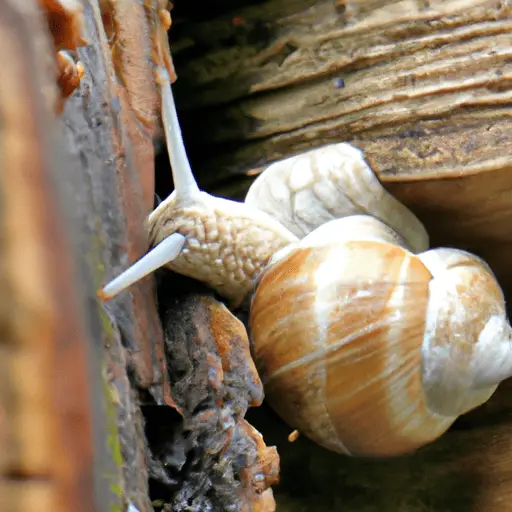
Examples of Specific Tree-Dwelling Snail Species and Their Habitats
One example of a tree-dwelling snail species is the island apple snail (Pomacea insularum), which lives on trees in freshwater environments throughout North America. These gastropods have adapted long respiratory tubes that allow them to breathe under water while clinging onto submerged branches or leaves during floods.
Another example is the Brazilian land snail (Megaxixis tenellus), which lives on moist trees in the Atlantic Forest region of Brazil. These tiny gastropods are known for their striking black shells with yellow stripes and can be spotted crawling slowly along tree trunks or leaves.
Tree-dwelling snails are a fascinating subset of gastropods that have evolved unique adaptations allowing them to live high above ground in various forested areas around the world. They prefer moist environments with mossy or damp bark textures on trees tall enough for protection yet not too steep for movement – providing ideal habitats for these amazing creatures!
The Wonderful World of Desert Snails
The desert is a harsh and unforgiving environment. With vast expanses of arid land, it’s no wonder that many animals struggle to survive in such a place.
However, some creatures have adapted to the unique challenges posed by the desert. Desert-dwelling snails are one such species.
Where They Can Be Found
Desert snails can be found in arid regions across the world. They typically live in areas with low vegetation cover, where they can easily access patches of damp soil or plant matter to feed on. Some species are found in rocky terrain while others live in sand dunes or on hardpan surfaces.
Adaptations for Survival
To survive in the harsh desert environment, desert snails have several important adaptations. One of the most notable is their ability to seal themselves inside their shells for extended periods of time. This helps them conserve water during times of drought and extreme heat.
Another adaptation is their ability to aestivate (a form of hibernation) during periods when temperatures become too high. During this time, they enter a state of torpor which allows them to conserve energy until conditions are more favorable.
Many desert snail species have evolved specialized feeding habits that allow them to extract moisture from even the driest plants and surfaces. Some species feed on lichens or algae while others scrape moisture off rocks or other hard surfaces using their radula (a specialized tongue-like structure).
Specific Species and Their Habitats
One example of a desert-dwelling snail is the Sonoran Desert Snail (Sphincterochila sonorensis). This species lives in Arizona, California, and Mexico and can be found on rocky hillsides with sparse vegetation cover.
Another example is the Mojave Fringe-toed Snail (Sphincterochila mojavensis). This species is found in the Mojave Desert in California and Nevada, where it lives on hardpan surfaces and feeds on lichens.
Overall, desert-dwelling snails are a fascinating group of creatures that have adapted to survive in one of the harshest environments on Earth. By studying their unique adaptations and behaviors, we can gain a greater appreciation for the incredible diversity of life that exists in our world.
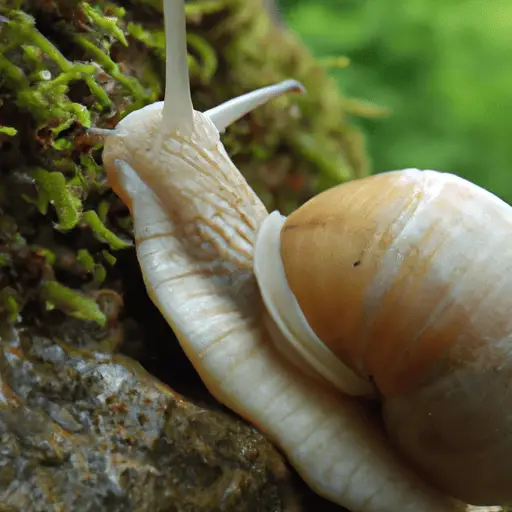
Conclusion: Where Do Snails Live?
Snails are fascinating creatures that can be found in a variety of habitats around the world. From land to water to trees and even deserts, these little creatures have adapted to survive in some of the most extreme environments on the planet.
Land snails prefer moist and shady areas where they can find plenty of vegetation to eat. They can be found in gardens, forests, and other natural settings.
Some species are even able to survive in urban environments such as parks and gardens. Aquatic snails are found in ponds, streams, rivers, and other slow-moving bodies of water.
These snails often serve an important role as indicators of water quality because they are sensitive to changes in their environment. They can also be used as a food source for fish and other aquatic animals.
Tree-dwelling snails thrive in tropical rainforests and temperate forests where they live on mossy or damp bark. They are commonly found at high elevations where the air is moist and cool.
These snails play an important role in their ecosystems by helping to break down plant material. Desert-dwelling snails have adapted unique characteristics that allow them to survive in harsh environments with limited resources.
Some species have a hard shell that protects them from predators, while others produce mucus that helps them retain moisture. Overall, it is clear that snails are incredibly adaptable creatures that have managed to thrive in a wide range of habitats around the world.
By studying these fascinating creatures, we can gain new insights into how life evolves and adapts over time. So the next time you see a snail crawling along your garden path or hanging out on a tree trunk, take a moment to appreciate just how remarkable these little creatures really are!


